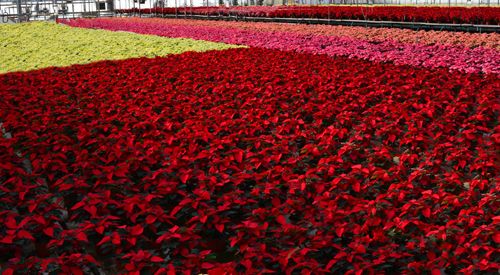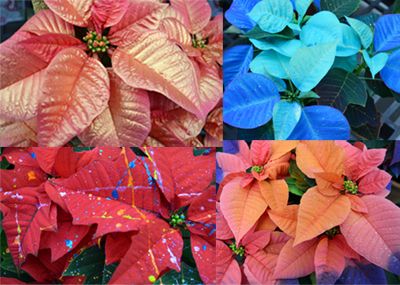Care of Poinsettias
Although each season has a look and feel all its own, the holiday season at Gertens takes on a special meaning. As one of the largest growers of Poinsettias in the Twin Cities, Gertens offers a wide range of colors and styles, from the traditional red, white, and pink of natural poinsettias, to our wide variety of painted colors.
 |
A Little History
Joel Roberts Poinsett was the first United States Ambassador to Mexico being appointed by President John Quincy Adams in the 1820's. At the time of his appointment, Mexico was involved in a civil war. Because of his interest in botany he introduced the American elm into Mexico. During his stay in Mexico he wandered the countryside looking for new plant species. In 1828 he found a beautiful shrub with large red flowers growing next to a road. He took cuttings from the plant and brought them back to his greenhouse in South Carolina. Even though Poinsett had an outstanding career as a United States Congressman and as an ambassador he will always be remembered for introducing the poinsettia into the United States.
Location and Temperature
The poinsettia thrives on bright, sunny natural daylight; at least six hours daily is recommended. Placement near a sunny window is ideal. To prolong the bright red of the bracts, temperatures ideally should not exceed 70° F during the day, or fall below 65° F at night. Be sure to avoid placing the plants near drafts, fluctuating air currents, excess heat and dry air from appliances, fireplaces or ventilating ducts. Chilling injury will occur if poinsettias are exposed to temperatures below 50° F. Frost will kill them.
Water and Fertilizer
Poinsettias do best with a moist soil condition, not too wet and not too dry. Water the poinsettia thoroughly when the soil surface feels dry to a light touch. The best indication of a thorough watering is when the water begins to seep through the drain holes at the bottom of the inner pot; water just enough so the water barely begins to seep through these holes. Be sure to discard any excess water, as poinsettias left sitting in water may suffer from permanent root-rot damage.
It is not necessary to fertilize your poinsettias when they are in bloom during the holiday season. However, after 6-8 weeks, a balanced, all-purpose household plant fertilizer mixed ½-strength will help maintain the rich, green foliage color and promote new growth. Repeat once more in another 6-8 weeks.
After the Holidays
Even if you don't have a gardener's green thumb, you may continue to enjoy the beauty of your poinsettia throughout the year as an attractive green foliage plant. At the end of April or early May, when the bracts age and begin to turn a muddy green, cut the plant back to about 8 inches. The amount you cut from the top will depend on the shape of the plant. Some plants will need to have more cut than others to achieve a full, rounded canopy. After you cut the plant back, it will probably look rather stark, with bare branches and bluntly cut woody stems. This is not the plant's most attractive state, but by the end of May you will see vigorous new growth as the plant develops more lush green foliage. Keep the plants near a sunny window.
You may place your plants outdoors where they can bask in the warmth of summer when the outside night temperatures are warmer. Continue to water the plants regularly during the growing period. Fertilize every 3 to 4 weeks throughout the spring, summer and fall months with a well-balanced fertilizer mixed ½-strength.
Around June 15th you may wish to transplant your poinsettias into larger pots, about 2" to 4" bigger than the original inner pot. Use a soil mix that incorporates a considerable amount of organic matter such as peat moss. You may also try planting them into a well-prepared garden bed rich in organic matter and with good drainage. Your poinsettias will do best in a protected area, preferably along a south garden wall. Immediately after transplanting, be sure to water thoroughly.
Re-flowering
The poinsettia is a photoperiod plant, which means it begins to set buds and produce flowers as the winter nights become longer. The plants will naturally come into full bloom during November or December depending upon the flowering response time of the particular variety. This can be tricky to do outside of a controlled greenhouse environment, because any stray artificial light such as that from a street light, pool light or household lamp could delay or halt the re-flowering of the plants.
Starting October 1, the plants must be kept in complete darkness for 14 continuous hours each night. This can be accomplished by moving the plants to a dark room or placing a large box over them. During this period, the plants require 6 to 8 hours of bright sunlight and night temperatures between 60° and 70° F. If the temperature is too high or too low, the setting of the flower buds may be delayed or halted. The blooming process may also be delayed or disrupted by any stray light that may shine near the plants during the critical darkness period. This regimen must continue for approximately 8 to 10 weeks in order for the plants to develop a colorful display of blooms for the holiday season. Obviously, the re-flowering process takes more than a little vigilance, perseverance and patience to be successful.
 |
| Sampling of Painted Poinsettias |
Poinsettias Are Not Poisonous
Since around 1919; an unsubstantiated tale has circulated concerning the alleged poisonous nature of poinsettias. To alleviate the public's fear, the Society of American Florists and Ohio State University conducted a scientific investigation into the safety of the poinsettia plant. The Ohio State University research on the poinsettia plant effectively disproved the charge that the poinsettia is harmful to human and animal health. Of course, the poinsettia, like all ornamental plants, is not intended for human and animal consumption.
